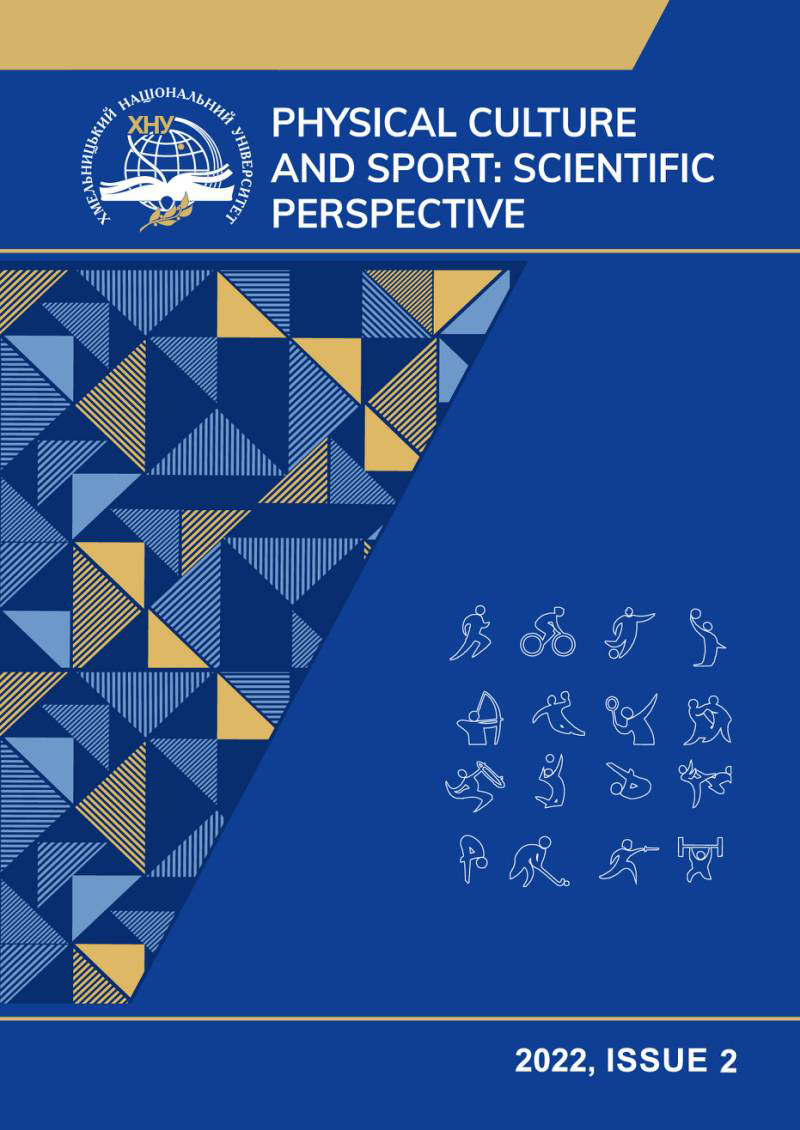ВИЗНАЧЕННЯ МОДЕЛЬНИХ ХАРАКТЕРИСТИК ТРАЄКТОРІЇ РУХУ ШТАНГИ У ПІДНІМАННІ НА ГРУДИ ВАЖКОАТЛЕТКАМИ ВИСОКОЇ КВАЛІФІКАЦІЇ
DOI:
https://doi.org/10.31891/pcs.2022.2.11Ключові слова:
важка атлетика, піднімання на груди, горизонтальне переміщення штанги, типи траєкторіїАнотація
У статті досліджено змагальну діяльність важкоатлеток високої кваліфікації та проведено аналіз траєкторії руху штанги у першій вправі поштовху – підніманні штанги на груди.
Основною метою дослідження було визначити типи траєкторії рухів штанги у підніманні на груди важкоатлетками високого класу. У дослідженнях проаналізовано спроби 140 важкоатлеток високої кваліфікації. В результаті аналізу успішних спроб у піднімані штанги на груди під час виступу на міжнародних змаганнях вдалось отримати співвідношення володіння важкоатлетками високої кваліфікації горизонтальної траєкторії руху у ввідповідності до різних вагових категорій. В результаті проведеного дослідження отримано дані, що показують значну перевагу використання важкоатлетками високої кваліфікації першого типу (А) траєкторії руху штанги у підніманні на груди. Встановлено, що у підніманні штанги на груди другий тип траєкторії (В) більше використовуються спортсменками легких вагових категорій (48-58 кг). Встановлено, що спортсменки (53) та найважчої вагової категорії (+75) в переважній більшості володіють (С) типом траєкторії руху штанги.
Посилання
Akkuş, H. Kinematic analysis of the snatch lift with elite female weightlifters during the 2010 World Weightlifting Championship. J. Strength Cond. Res. 2012, 26, 897–905.
Antonio U. Weightlifting. Sport for all sports / Antonio Urso // Copyright: Calzetti & Mariucci Publishers:. Topografia Mancini. – May 2011. – 176 р.
Antoniuk O.V., & Pavlyuk E.A. (2016) Characteristics of barbell trajectory in snatch, fulfilled by elite female weight-lifters. Pedagogics, psychology, medical-biological problems of physical training and sports, 2016;6:4–8.
Baumann, W, Gross, V, Quade, K, Galbierz, P, and Schwirtz, A. The snatch technique of world class weight lifters at the 1985 world championships.Int J Sport Biomech 4: 68–89, 1998.
Campos J. Kinematical analysis of the snatch in elite male junior weightlifters of different weight categories / J. Campos, P. Poletaev, A. Cuesta, C. Pablos, V. Carratalá // J Strength Cond Res.– 2006 Nov.– №20(4).– Р. 843–50.
Garhammer, J. Bar trajectories of world champion male and female weightlifters: Coaching applications, Part 1. Int Olympic Lifter10: 7–8, 1990.
Garhammer, J. Weightlifting performance and techniques of men and women. In:First International Conference on Weightlifting and Strength Training. P.V. Komi, ed. Lahti, Finland: Gummerus Printing, 1998. pp. 89–94.
Gourgoulis, V, Aggeloussis, N, Mavromatis, G, and Garas, A. Threedimensional kinematic analysis of the snatch of elite Greek weightlifters.J Sport Sci18: 643–652, 2000.
Hancock S., Wyatt F., and Kilgore L. Variation in Barbell Position Relative to Shoulder and Foot Anatomical Landmarks Alters Movement Efficiency. International Journal of Exercise Science 5(3) : 183-195, 2012.
Hasan Akkusx. Kinematic analysis of the snatch lift with elite female weightlifters during the 2010 World Weightlifting Championship.J Strength Cond Res26(4): 897–905, 2012.
Hiskia, G. Biomechanical analysis of world and Olympic champion weightlifters performance. In:Proceedings of the Weightlifting Symposium. A. Lukacsfalvi and F. Takacs, eds. Budapest, Hungary: IWF, 1997. pp. 137–158.
Hoover, DL, Carlson, KM, Christensen, BK, and Zebas, CJ.Biomechanical analysis of women weightlifters during the snatch. J Strength Cond Res20: 627–633, 2006.
Ikeda, Y, Jinji, T, Matsubayashi, T, Matsuo, A, Inagaki, E, Takemata, T, and Kikuta, M. Comparison of the snatch technique for female weightlifters at the 2008 Asian Championships.J Strength Cond Res26: 1281–1295, 2012.
Korkmaz S, Harbili E. Biomechanical analysis of the snatch technique in junior elite female weightlifters. / S. Korkmaz, E. Harbili // Journal of Sports Sciences. – 2016 Jun 2. – № 34(11). – рр. 1088-93.
Musser, Leslie J. "The effect of anthropometry on barbell trajectory for elite female weightlifters at the 2009 pan american championships." PhD diss., CALIFORNIA STATE UNIVERSITY, LONG BEACH, 2010., 86 pages; 1486708.
Musser, LJ, Garhammer, J, Rozenek, R, Crussemeyer, JA, and Vargas, EM. Anthropometry and barbell trajectory in the snatch lift for elite women weightlifters. J Strength Cond Res 28(6): 1636–1648, 2014
Nejadian S.L., Rostami M., Naghash A. Cost evaluation of different snatch trajectories by using dynamic programming method / 8th Conference of the International Sports Engineering Association. Procedia Engineering 2 (2010) 2563–2567
Okada, J, Iijima, K, Fukunaga, T, Kikuchi, T, and Kato, K. Kinematic analysis of the snatch technique used by Japanese and international female weightlifters at the 2006 Junior World Championships. Int J Sport Health Sci6: 194–202, 2008.
Oleshko V.G. Training of athletes in strength sports: {{Educational guide}}. / V.G. Oleshko - K.: DIA, 2011. - 444 p.
Petrizzo J, DiMenna FJ, Page R, Smith G, Martins K, Lester J, Kang S, Chandler L, Wygand JW, Otto RM. Altered Start Position Reduces Horizontal Displacement during the Snatch and Clean. JEPonline 2016;19(3):24-34.
Schilling В., Stone M., O'Bryant H., Fry A.C., Coglianese R., Pierces K.. Snatch Technique of Collegiate National Level Weightlifters // Journal of Strength and Conditioning Research, - 2002.- No. 16(4).- P. 551-555.
Stephen J. Rossi, Thomas W. Buford, Douglas B. Smith, Robin Kennel, Erin E. Haff, and G. Gregory Haff. Bilateral Comparison of Barbell Kinetics and Kinematics During a Weightlifting Competition. International Journal of Sports Physiology and Performance, 2007;2:150-158.
Tovstonoh.O. Individualization technical training weightlifting at the stage of specialized basic training. Ldufk. Lviv. 2012. Electronic repository. https://repository.ldufk.edu.ua/bitstream/34606048/8047/1/tovstonoh_o_i.PDF





